Sarah L. Johnson's Blog, page 94
January 18, 2015
Book review, with notes: Kate Alcott's A Touch of Stardust
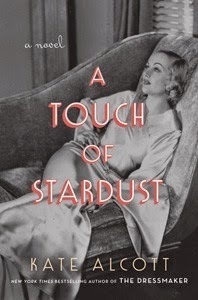 Alcott should entrance large audiences with her stellar historical novel, which follows fictional Indiana native Julie Crawford after she moves to Los Angeles in 1938 to become a screenwriter. Readers expecting a rehash of a familiar plotline, however—that of a young hopeful becoming disillusioned by the emptiness beneath Hollywood’s glitzy veneer—will find something more nuanced and substantive.
Alcott should entrance large audiences with her stellar historical novel, which follows fictional Indiana native Julie Crawford after she moves to Los Angeles in 1938 to become a screenwriter. Readers expecting a rehash of a familiar plotline, however—that of a young hopeful becoming disillusioned by the emptiness beneath Hollywood’s glitzy veneer—will find something more nuanced and substantive.Working as an assistant to exuberant blonde actress Carole Lombard, who hails from her hometown, Julie gets pulled into the activity surrounding the filming of Gone with the Wind, costarring Clark Gable, the still-married man Carole loves (and vice versa). On and off the set, considerable drama unfolds; all the actors and crew are subjected to the single-minded vision of its controlling producer, David Selznick.
Both Carole and diminutive brunette Vivien Leigh light up the page in their scenes, and Julie’s story line holds its own alongside theirs. As she sheds her midwestern naïveté and works hard on a screenplay in her free time, her romance with a Jewish assistant producer draws in themes of prejudice and hypocrisy.
The briskly paced narrative captivates as it lets readers view the creation of silver-screen magic, and it’s also a terrific tribute to the industry pioneers, like screenwriter Frances Marion, who helped others jump-start their dreams.
~
A Touch of Stardust will be published by Doubleday next month ($25, hardcover, 304pp). I wrote this starred review for Booklist's November 15th issue. Some additional notes:
- "Kate Alcott" is a pseudonym for veteran novelist and journalist Patricia O'Brien, and this is the only novel of hers written under this name that I've read (the first, a breakout hit, was The Dressmaker).
- However, I thoroughly enjoyed her earlier novel written as O'Brien, Harriet & Isabella, about the relationship between 19th-century sisters Harriet Beecher Stowe and Isabella Beecher Hooker as they revisit the adultery trial of their brother, charismatic preacher Henry Ward Beecher. Apparently this book didn't perform well sales-wise, which eventually led to her adoption of a pseudonym, but I suspect that had less to do with the quality of the story than the fact that the Beecher family are no longer household names. I love this period in American history, though, and highly recommend this underrated novel. I interviewed O'Brien about Harriet & Isabella here back in 2008.
- In addition to everything I mentioned in the review, Alcott also smoothly intertwines a secondary thread involving the African-American actors (Hattie McDaniel and Butterfly McQueen) in GWTW, particularly their conflict between the breakout opportunity the film was for them and the demeaning roles they played. Although they were respected as professionals by their fellow actors, this wasn't the case everywhere. In the novel, as in history, Clark Gable was outraged and outspoken on their behalf when they experienced instances of segregation on set and at the time of the film's premiere.
- The cover design has changed since the ARC; the final one, above, is an improvement in my opinion. Very classy.
- A Touch of Stardust is one of 10 titles on the February 2015 LibraryReads list. These are the top 10 reads for a given month selected by public library staff members across the U.S. (as an academic librarian, unfortunately I can't participate in this initiative, but I enjoy seeing what this group comes up with). I've read three of the ten for February and will be posting reviews of the remaining two (The Siege Winter and The Secrets of Sir Richard Kenworthy) shortly.
Published on January 18, 2015 09:08
January 16, 2015
The 2014 Langum Prize for American Historical Fiction: Winner and Honorees
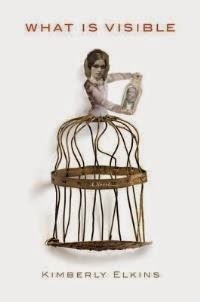 The winner of the 2014 David J. Langum, Sr. Prize for American Historical Fiction is Kimberly Elkins' What Is Visible (Twelve, 2014).
The winner of the 2014 David J. Langum, Sr. Prize for American Historical Fiction is Kimberly Elkins' What Is Visible (Twelve, 2014).From the judges' remarks in the press release:
"This novel lyrically revives a significant and intriguing figure in the history of disability. Laura Bridgman (d. 1889) was a celebrity in her lifetime. Stripped of sight, hearing, taste and smell by scarlet fever in her childhood, Bridgman served as a poster child for the Perkins School for the Blind and various intellectual causes such as phrenology and anti-Calvinism.
"What sets this novel apart is the author’s ability to imagine Laura Bridgman’s world and to give her a powerful narrative voice. With skill and compassion, Elkins portrays Bridgman as a complicated character whose strengths and flaws grow more complex as the story progresses. Historical details enrich the story, and the author deftly exposes the care and treatment of the disabled during the 1800s. This is American historical fiction at its best."
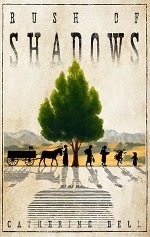 The 2014 Honorable Mention went to Catherine Bell's Rush of Shadows (Washington Writers’ Publishing House, 2014), a "sparsely but beautifully written novel" that focuses on farmers of Northern California’s Sacramento Valley and their encounters with the native Digger Indians in the 1850s.
The 2014 Honorable Mention went to Catherine Bell's Rush of Shadows (Washington Writers’ Publishing House, 2014), a "sparsely but beautifully written novel" that focuses on farmers of Northern California’s Sacramento Valley and their encounters with the native Digger Indians in the 1850s. From the judges' comments: "This is truly fresh material. The Trail of Tears is well-known, but Indian removals in California are relatively obscure. The characters are well-drawn and the descriptions vivid. A beautiful book."
Finally, Laila Lalami's The Moor's Account (Pantheon, 2014) was named as the Director's Mention for 2014.
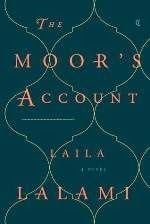 "While The Moor's Account does not fully meet the requirements for the prize," the judges note, it is praised as an "extraordinary, pitch-perfect work of historical fiction about the Narváez expedition in Florida."
"While The Moor's Account does not fully meet the requirements for the prize," the judges note, it is praised as an "extraordinary, pitch-perfect work of historical fiction about the Narváez expedition in Florida."For more on the prize and the full announcement of this year's honorees, see the Langum Charitable Trust. To submit a novel for consideration, view the directions available at the site; the Trust has also issued guidelines used by their readers and selection committee, which authors should find useful as well. The prize is awarded annually to the "best book in American historical fiction that is both excellent fiction and excellent history."
Past years' winners include Gary Schanbacher's Crossing Purgatory, Ron Rash's The Cove, Julie Otsuka's The Buddha in the Attic, Ann Weisgarber's The Personal History of Rachel DuPree, Edward Rutherfurd's New York, and Kathleen Kent's The Heretic's Daughter.
Published on January 16, 2015 06:00
January 13, 2015
Citizens Creek by Lalita Tademy, a little-known American story worth learning
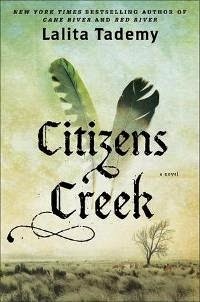 Whether you read historical fiction to be educated, entertained, or both, Citizens Creek will get you squared away.
Whether you read historical fiction to be educated, entertained, or both, Citizens Creek will get you squared away. The title refers to a people rather than a place, just one of the many aspects of the novel that will make you think. It spans almost a century in the lives of Cow Tom and his granddaughter Rose, from his youth as a slave and hilis haya (healer) of cattle on an Upper Creek chief’s Alabama plantation through her later years as an Oklahoma rancher and family matriarch.
Their struggles and rise to prominence make for a classic American success story, and it’s especially inspiring because the characters are based on historical people. They deserve to be more widely known, and Tademy has done well in resurrecting them in her latest work of fiction.
In 1822, when he’s twelve years old, Cow Tom’s mentor, Old Turtle, tells him: “Owned by tribe’s not the same as tribe.” One of Cow Tom’s lifelong goals is to secure freedom and tribal citizenship for all people of African descent living within the Creek Nation. He has a talent for languages, which puts him in demand as a translator during the whites’ Indian wars and their harsh Removal policy, in which tribes living east of the Mississippi were displaced to lands in the West.
Cow Tom also remains determined to find his mother, who was stolen away by Seminoles when he was a child, and uses every possible opportunity on his assignments in Florida to locate her. His achievements on behalf of other African Creeks are impressive (I won’t spoil the details for those who don’t know them), but he also does some things he’s ashamed of. For Rose, being chosen years later as the recipient and bearer of his personal history is equally an honor and a burden.
This is the type of novel that’s best read slowly and carefully. Sometimes one chapter will follow closely upon another, while at other times they’re set years apart. The author’s admirable aim of covering such a wide stretch of years gives the book an episodic feel in places. There are so many people in it with interesting stories and backstories, though. Cow Tom’s wife Amy, for instance, is a smart, tough woman who could easily have starred in a novel herself.
In turning up slices of history unknown to most readers, Tademy has written a stirring work about endurance, liberty, family, and belonging. Cow Tom’s own words to Rose in the novel describe his journey best:
“From early, I had to aim higher than my name, an offhand thing tossed out to make it easier for someone to call me. The name fit, far as it went, but I was more than a tender of cows. I was a tender of words, and of people, and master of myself.”
Citizens Creek was published by Atria/Simon & Schuster in November ($26.00, hardcover, 432pp). Thanks to the publisher for granting me access via Edelweiss.
Published on January 13, 2015 17:27
January 12, 2015
Etowah: Trade Center of the Mississippian Culture, a guest post by Kristin Gleeson
When Kristin Gleeson first mentioned her idea to contribute an essay about Etowah, I was intrigued and expressed interest in learning more. Here she presents an introduction to it and other large American cities that flourished across the continent before the Europeans arrived.
~
Etowah: Trade Center of the Mississippian CultureKristin Gleeson
Twelfth-century America is the setting for a large portion of my novel, Along the Far Shores, which uses the legend of Prince Madog of Wales’ voyage to America as a framework for the plot. The legend puts Madog/Madoc in Mobile Bay and up along the Mississippian Valley, in Southeastern part of North America, an area and time period virtually unknown to most people.
 Mention the Aztec, Maya and Inca, whose existence overlapped in this time, and so many images come to mind: pyramid temples, gold hoards, bloody sacrifices, elaborate sculptures and ball games where the losing sides were sacrificed. There is also the well-known story of the Aztec chief, Montezuma, who was captured and eventually killed by the Spaniards in the 15th century. Few people, however, would know about the Mississippian culture, which flourished for almost 900 years, c. 600-1500 A.D., and, like the more well-known Central and South American counterparts, had great urban centers, some of them more populous than any city of Europe at the time.
Mention the Aztec, Maya and Inca, whose existence overlapped in this time, and so many images come to mind: pyramid temples, gold hoards, bloody sacrifices, elaborate sculptures and ball games where the losing sides were sacrificed. There is also the well-known story of the Aztec chief, Montezuma, who was captured and eventually killed by the Spaniards in the 15th century. Few people, however, would know about the Mississippian culture, which flourished for almost 900 years, c. 600-1500 A.D., and, like the more well-known Central and South American counterparts, had great urban centers, some of them more populous than any city of Europe at the time.
It was along the fertile valleys of the Mississippi and its tributaries that these cities arose. Ocmulgee, Etowah, Cahokia, Moundville and Spiro were some of the biggest cities. The region stretched from the Atlantic coast to Arkansas and Oklahoma and up as far as Wisconsin. A new strain of maize and later Mexican beans and squash supported this growing population that previously had been limited by dependence for food on game or fish that might be scarce in any given year. With a reliable food source, these communities were able to turn their attention to fashioning pottery, pipes, cups, jewelry, head ornaments of feathers and copper, wooden and stone sculptures, woven articles, cloth and copper products. The pipes, for example, used often for ceremonial purposes, were elaborately carved from materials like obsidian or bauxite into mythical figures such as Big Boy, the warrior priest dressed in a falcon costume, who also appeared on shells and copper plates. Or like the two sculpted marble figures, a man and a woman, nearly 3 feet tall found at Etowah.
 Marble effigies from the Etowah Mound C, ca. 1375. Source: Herb Roe via Wikimedia Commons
Marble effigies from the Etowah Mound C, ca. 1375. Source: Herb Roe via Wikimedia Commons
All these items Etowah and other cities traded along with raw commodities like obsidian, gold, silver and conch shells. Trade grew into important networks that linked much of the Midwest and East. Such links offered many chances for sharing and improving skills, acquiring or modifying languages, religious and cultural practices.
Etowah, located in north central Georgia, was one of the largest cities of the Mississippian culture, and its remains are still evident. Surrounded by a moat and a bastioned wooden palisade, it had six earthen mounds that loomed over the city. The three largest mounds were grouped around a large plaza, the most central one rising 61 feet with a base that covered about 3 acres. Its flattened top extended to about ¾ size of a football field and commanded an impressive view of the surrounding plain. A second plaza, paved with clay was to the east and had a ramp that extended from the plaza to the summit of the first mound.
 A pic of the Etowah Mound Site in Cartersville, Ga. Source: Herb Roe via Wikimedia Commons
A pic of the Etowah Mound Site in Cartersville, Ga. Source: Herb Roe via Wikimedia Commons
In later centuries a small elite, The Nobles/Honored Men, lived on top of the mounds near to the all-important temple. Their houses were colorfully painted and decorated with elaborate designs and housed richly carved items. The commoners living in the plains below the nobles dubbed “the Stinkards.” The Great Sun was the leader and his relatives, known as Suns, held the city’s administrative positions. The political dominance of this elite group usually extended beyond the city to the surrounding areas, where lesser chiefs ruled small towns. All members of the region and the city were obligated to send tribute to the Great Sun periodically. Once the Great Sun died, this strong regional network often fragmented if there wasn’t a strong person to replace him.
Etowah and the other cities remained largely autonomous, but extensive economic and kin ties created far-flung alliances and rivalries so that the competition for power and prestige gradually intensified over the centuries. Ancestral obligations became more important, as did celebrations of successful harvests, hunts and warfare.
Other rituals, like ball games, became increasingly important and had deep religious connections. It is possible these ball games may have been the origin of the popular Boskita and Chunkey played in parts of the Southeast in later times. Boskita was like an earlier form of lacrosse with up to 60 players on each side, with up to five squads. Players carried two sticks shaped somewhat like a tennis rackets strung with deer hide thongs. The field was nearly a quarter of a mile long with a goal at each end formed by two uprights and a crossbar. Chunkey, on the other hand, was played with a disk, 3 to 6 inches in diameter, made from stone. These ball games appear to have had various meanings, some of them representing man and the cosmos.
With the arrival of De Soto and other Europeans in the 1500s, disease and disorder overtook the Mississippian cities that weren’t already in decline and decimated the population. There were too few people to construct massive earthworks, host elaborate rituals and celebrations or pay tribute to an exalted leader on the scale of previous time periods. Smaller bands and communities survived and eked their living to the best of their ability while only remnants of rituals and crafts remained.
~
Originally from Philadelphia, Kristin Gleeson lives in Ireland, in the West Cork Gaeltacht, where she teaches art classes, plays harp, sings in an Irish choir and runs two book clubs for the village library. She combines her love of myths with her harp playing and performed as a professional harper/storyteller at events in Britain, America and Ireland. She holds a Masters in Library Science and a Ph.D. in history, and for a time was an administrator of a national archives, library and museum in America. Her newest novel, Along the Far Shores, was published in November by An Tig Beag ($12.99 pb, $2.99 ebook).
~
Etowah: Trade Center of the Mississippian CultureKristin Gleeson
Twelfth-century America is the setting for a large portion of my novel, Along the Far Shores, which uses the legend of Prince Madog of Wales’ voyage to America as a framework for the plot. The legend puts Madog/Madoc in Mobile Bay and up along the Mississippian Valley, in Southeastern part of North America, an area and time period virtually unknown to most people.
 Mention the Aztec, Maya and Inca, whose existence overlapped in this time, and so many images come to mind: pyramid temples, gold hoards, bloody sacrifices, elaborate sculptures and ball games where the losing sides were sacrificed. There is also the well-known story of the Aztec chief, Montezuma, who was captured and eventually killed by the Spaniards in the 15th century. Few people, however, would know about the Mississippian culture, which flourished for almost 900 years, c. 600-1500 A.D., and, like the more well-known Central and South American counterparts, had great urban centers, some of them more populous than any city of Europe at the time.
Mention the Aztec, Maya and Inca, whose existence overlapped in this time, and so many images come to mind: pyramid temples, gold hoards, bloody sacrifices, elaborate sculptures and ball games where the losing sides were sacrificed. There is also the well-known story of the Aztec chief, Montezuma, who was captured and eventually killed by the Spaniards in the 15th century. Few people, however, would know about the Mississippian culture, which flourished for almost 900 years, c. 600-1500 A.D., and, like the more well-known Central and South American counterparts, had great urban centers, some of them more populous than any city of Europe at the time.It was along the fertile valleys of the Mississippi and its tributaries that these cities arose. Ocmulgee, Etowah, Cahokia, Moundville and Spiro were some of the biggest cities. The region stretched from the Atlantic coast to Arkansas and Oklahoma and up as far as Wisconsin. A new strain of maize and later Mexican beans and squash supported this growing population that previously had been limited by dependence for food on game or fish that might be scarce in any given year. With a reliable food source, these communities were able to turn their attention to fashioning pottery, pipes, cups, jewelry, head ornaments of feathers and copper, wooden and stone sculptures, woven articles, cloth and copper products. The pipes, for example, used often for ceremonial purposes, were elaborately carved from materials like obsidian or bauxite into mythical figures such as Big Boy, the warrior priest dressed in a falcon costume, who also appeared on shells and copper plates. Or like the two sculpted marble figures, a man and a woman, nearly 3 feet tall found at Etowah.
 Marble effigies from the Etowah Mound C, ca. 1375. Source: Herb Roe via Wikimedia Commons
Marble effigies from the Etowah Mound C, ca. 1375. Source: Herb Roe via Wikimedia CommonsAll these items Etowah and other cities traded along with raw commodities like obsidian, gold, silver and conch shells. Trade grew into important networks that linked much of the Midwest and East. Such links offered many chances for sharing and improving skills, acquiring or modifying languages, religious and cultural practices.
Etowah, located in north central Georgia, was one of the largest cities of the Mississippian culture, and its remains are still evident. Surrounded by a moat and a bastioned wooden palisade, it had six earthen mounds that loomed over the city. The three largest mounds were grouped around a large plaza, the most central one rising 61 feet with a base that covered about 3 acres. Its flattened top extended to about ¾ size of a football field and commanded an impressive view of the surrounding plain. A second plaza, paved with clay was to the east and had a ramp that extended from the plaza to the summit of the first mound.
 A pic of the Etowah Mound Site in Cartersville, Ga. Source: Herb Roe via Wikimedia Commons
A pic of the Etowah Mound Site in Cartersville, Ga. Source: Herb Roe via Wikimedia CommonsIn later centuries a small elite, The Nobles/Honored Men, lived on top of the mounds near to the all-important temple. Their houses were colorfully painted and decorated with elaborate designs and housed richly carved items. The commoners living in the plains below the nobles dubbed “the Stinkards.” The Great Sun was the leader and his relatives, known as Suns, held the city’s administrative positions. The political dominance of this elite group usually extended beyond the city to the surrounding areas, where lesser chiefs ruled small towns. All members of the region and the city were obligated to send tribute to the Great Sun periodically. Once the Great Sun died, this strong regional network often fragmented if there wasn’t a strong person to replace him.
Etowah and the other cities remained largely autonomous, but extensive economic and kin ties created far-flung alliances and rivalries so that the competition for power and prestige gradually intensified over the centuries. Ancestral obligations became more important, as did celebrations of successful harvests, hunts and warfare.
Other rituals, like ball games, became increasingly important and had deep religious connections. It is possible these ball games may have been the origin of the popular Boskita and Chunkey played in parts of the Southeast in later times. Boskita was like an earlier form of lacrosse with up to 60 players on each side, with up to five squads. Players carried two sticks shaped somewhat like a tennis rackets strung with deer hide thongs. The field was nearly a quarter of a mile long with a goal at each end formed by two uprights and a crossbar. Chunkey, on the other hand, was played with a disk, 3 to 6 inches in diameter, made from stone. These ball games appear to have had various meanings, some of them representing man and the cosmos.
With the arrival of De Soto and other Europeans in the 1500s, disease and disorder overtook the Mississippian cities that weren’t already in decline and decimated the population. There were too few people to construct massive earthworks, host elaborate rituals and celebrations or pay tribute to an exalted leader on the scale of previous time periods. Smaller bands and communities survived and eked their living to the best of their ability while only remnants of rituals and crafts remained.
~
Originally from Philadelphia, Kristin Gleeson lives in Ireland, in the West Cork Gaeltacht, where she teaches art classes, plays harp, sings in an Irish choir and runs two book clubs for the village library. She combines her love of myths with her harp playing and performed as a professional harper/storyteller at events in Britain, America and Ireland. She holds a Masters in Library Science and a Ph.D. in history, and for a time was an administrator of a national archives, library and museum in America. Her newest novel, Along the Far Shores, was published in November by An Tig Beag ($12.99 pb, $2.99 ebook).
Published on January 12, 2015 05:00
January 8, 2015
Galápagos Regained by James Morrow, a satirical romp through 19th-century South America
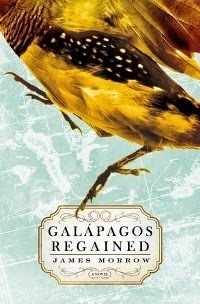 Morrow’s newest cheerfully provocative epic stars the intrepid Chloe Bathurst, who takes a job as Charles Darwin’s assistant zookeeper after getting fired from the Victorian theater. To raise cash to free her indebted father from the workhouse, she decides to enter the Shelley Society’s lucrative contest, which aims to settle the “pesky God question” for good.
Morrow’s newest cheerfully provocative epic stars the intrepid Chloe Bathurst, who takes a job as Charles Darwin’s assistant zookeeper after getting fired from the Victorian theater. To raise cash to free her indebted father from the workhouse, she decides to enter the Shelley Society’s lucrative contest, which aims to settle the “pesky God question” for good.When her employer declines to use his unpublished evolutionary theory to grab the winnings for himself, Chloe secretly copies his treatise, secures funding and a ship, and heads for the Galápagos isles to gather evidence for his Tree of Life. As she and her eccentric fellow travelers descend into the Amazon jungle while traversing South America, they encounter many obstacles.
The lofty narrative tone lends period authenticity, and there are some great comic moments as the characters undergo crises of faith. Fans of quest adventures may find the pacing exasperatingly sluggish, as the plot often gets buried under numerous details and digressions. For those fascinated by the meeting point between theology and science, though, it should be a rewarding expedition.
Galápagos Regained was published this week in hardcover by St. Martin's (496pp, $27.99). This review first appeared in Booklist's December 15th issue.
Some notes:
- I loved James Morrow's The Last Witchfinder , which (like this one) is a picaresque adventure novel about a woman's quest. It's set in Restoration England and 18th-century America and takes on the themes of bigotry and superstition during the age of witch-hunting. From the first sentence ("May I speak candidly, fleshling, one rational creature to another, myself a book and you a reader?" – it's narrated by the Principia Mathematica, you see), I was captured by the writing, humor, and originality. Definitely recommended. I reviewed it for Booklist in 2006; it was my first starred review for them.
- Galápagos Regained started out promisingly for me as well. The scenes on Darwin's estate in England are terrific, and the author's wit is as sharp and clever as always, but other parts were, well, simply too long and detailed. Reviews are mixed; Kirkus wasn't keen, Library Journal loved it, and Publishers Weekly admired its sense of fun but also said it was overlong. I cautiously recommend it and would be interested to hear what others think, if you decide to read it.
Published on January 08, 2015 09:00
January 5, 2015
Book review: Tessa Arlen's Death of a Dishonorable Gentleman
Combining the pleasurable dramas of the English country house novel and the richly detailed, tense atmosphere of a historical mystery, this involving debut features the unusual detective partnership between an aristocrat and her housekeeper. That said, the Countess of Montfort and Mrs. Jackson are not exactly BFFs. Tessa Arlen is too attuned to early 20th-century class distinctions to let that happen. When asked by her desperate employer to observe conversations below stairs at Iyntwood and report back, Mrs. Jackson is appalled, but her allegiance to the family she serves prods her along.
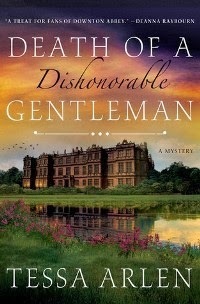 The murder victim of the title is Teddy Mallory, the spoiled only son of Lord Montfort’s sister. While everyone is horrified by the circumstances of his death (he’s found hanging from a gamekeeper’s gibbet the morning after the Montforts’ renowned summer party), he wasn’t well-liked. The mostly-unlamented Teddy has a long history of disreputable behavior, some of which is yet undiscovered. Even more curiously, two women, one a houseguest and one a new maid named Violet, vanished the same day.
The murder victim of the title is Teddy Mallory, the spoiled only son of Lord Montfort’s sister. While everyone is horrified by the circumstances of his death (he’s found hanging from a gamekeeper’s gibbet the morning after the Montforts’ renowned summer party), he wasn’t well-liked. The mostly-unlamented Teddy has a long history of disreputable behavior, some of which is yet undiscovered. Even more curiously, two women, one a houseguest and one a new maid named Violet, vanished the same day.
The arrival of an aggressive Scotland Yard investigator with no respect for his betters throws the household into even more disarray. Because the Montforts’ heir, Harry, was seen having a vicious argument with Teddy, he appears guilty at first. However, his mother, Clementine, believes in his innocence and enlists Mrs Jackson to keep her ears to the ground.
Among the houseguests are a dizzying bevy of socialites, introduced for the most part all at once. The characters have the advantage here, since they know who’s who better than readers will, but over the course of the novel, their distinctive personalities sort themselves out.
The shifting rapport between the central pair of allies – an unconventional yet privileged noblewoman and an upper servant whose brusque efficiency and “hierarchical cast of mind” belies her relative youth – is one of the novel’s high points. Arlen has a firm grasp on period mindsets and, as expected of any novel set in England in 1913, she inserts relevant details on the changes sweeping the country, such as women’s suffrage – a movement many female characters resist.
The lovely descriptions of the rolling green countryside around Iyntwood place us right into that glorious setting. Through its master’s thoughtful reflections on his “still-feudal way of life” while on a morning’s ride around his estates, we also get a solid sense of his family’s long-entrenched relationship with the land and his protectiveness toward his servants – even though, he admits, he “wasn’t terribly sure what Violet looked like.” The book is full of these small but telling details.
In this not-quite cozy mystery, the resolution to the crime unfolds in a logical manner. Sufficient clues are planted to let readers guess the culprit a bit early. Since they make an impressive and successful team, I hope Lady Montfort and Mrs. Jackson will join their wits again in future volumes – in particular, it should be interesting to see how much the characters relax their social attitudes as World War I gets underway.
~
Death of a Dishonorable Gentleman will be published by Minotaur/St. Martin's Press tomorrow in hardcover ($25.99, 320pp). This post is among the first out of the gate for the blog tour hosted by Historical Fiction Virtual Book Tours. Thanks to the publisher for approving my NetGalley copy.
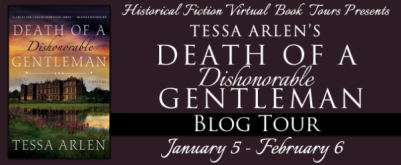
 The murder victim of the title is Teddy Mallory, the spoiled only son of Lord Montfort’s sister. While everyone is horrified by the circumstances of his death (he’s found hanging from a gamekeeper’s gibbet the morning after the Montforts’ renowned summer party), he wasn’t well-liked. The mostly-unlamented Teddy has a long history of disreputable behavior, some of which is yet undiscovered. Even more curiously, two women, one a houseguest and one a new maid named Violet, vanished the same day.
The murder victim of the title is Teddy Mallory, the spoiled only son of Lord Montfort’s sister. While everyone is horrified by the circumstances of his death (he’s found hanging from a gamekeeper’s gibbet the morning after the Montforts’ renowned summer party), he wasn’t well-liked. The mostly-unlamented Teddy has a long history of disreputable behavior, some of which is yet undiscovered. Even more curiously, two women, one a houseguest and one a new maid named Violet, vanished the same day.The arrival of an aggressive Scotland Yard investigator with no respect for his betters throws the household into even more disarray. Because the Montforts’ heir, Harry, was seen having a vicious argument with Teddy, he appears guilty at first. However, his mother, Clementine, believes in his innocence and enlists Mrs Jackson to keep her ears to the ground.
Among the houseguests are a dizzying bevy of socialites, introduced for the most part all at once. The characters have the advantage here, since they know who’s who better than readers will, but over the course of the novel, their distinctive personalities sort themselves out.
The shifting rapport between the central pair of allies – an unconventional yet privileged noblewoman and an upper servant whose brusque efficiency and “hierarchical cast of mind” belies her relative youth – is one of the novel’s high points. Arlen has a firm grasp on period mindsets and, as expected of any novel set in England in 1913, she inserts relevant details on the changes sweeping the country, such as women’s suffrage – a movement many female characters resist.
The lovely descriptions of the rolling green countryside around Iyntwood place us right into that glorious setting. Through its master’s thoughtful reflections on his “still-feudal way of life” while on a morning’s ride around his estates, we also get a solid sense of his family’s long-entrenched relationship with the land and his protectiveness toward his servants – even though, he admits, he “wasn’t terribly sure what Violet looked like.” The book is full of these small but telling details.
In this not-quite cozy mystery, the resolution to the crime unfolds in a logical manner. Sufficient clues are planted to let readers guess the culprit a bit early. Since they make an impressive and successful team, I hope Lady Montfort and Mrs. Jackson will join their wits again in future volumes – in particular, it should be interesting to see how much the characters relax their social attitudes as World War I gets underway.
~
Death of a Dishonorable Gentleman will be published by Minotaur/St. Martin's Press tomorrow in hardcover ($25.99, 320pp). This post is among the first out of the gate for the blog tour hosted by Historical Fiction Virtual Book Tours. Thanks to the publisher for approving my NetGalley copy.

Published on January 05, 2015 05:00
December 31, 2014
Looking back on 2014: A dozen excellent historical reads
This is another of those "favorite books" posts that have been springing up on numerous blogs at the end of the year. I thought about coming up with 10, but that was too difficult, so I decided on a dozen – and choosing even those was a challenge.
According to Goodreads, I read 109 books during 2014, and most were strong, good-looking, and above average. A fair many were excellent, and if I thought about my picks even more, I might have come up with a different list. These are all books I read during the last year, even if they were published earlier, or will be published later.
I found it interesting to see there isn't much overlap with the Goodreads list for Best Historical Fiction, as voted on by readers. I've read only five of the 20 finalists, and just two (My Name Is Resolute and Secret Life of Violet Grant) made it to my list. Another, Emma Donoghue's Frog Music, was outstanding, but I read it as an ARC in 2013.
Hope you all had a good reading year, and I'm looking forward to the new crop of books in 2015. Thanks for reading along with me.
And now for the list. The links lead to my reviews of the books, if they exist.
Joseph Boyden, The Orenda (Knopf, 2014). Boyden’s mesmerizing third novel sits at the confluence of three civilizations in 17th-century Ontario: the French, the Iroquois, and the Huron (Wendat). Despite the cultures’ disparate beliefs, the author remains clear-sighted and impartial, and the scenes of Native spirituality are beautifully rendered.
Alix Christie, Gutenberg’s Apprentice (Harper, 2014). This gorgeously written debut, an inspiring tale of ambition, camaraderie, betrayal, and cultural transformation set in the cathedral city of fifteenth-century Mainz, dramatizes the creation of the Gutenberg Bible. I hadn’t heard of Peter Schoeffer or his important historical role before this, and it was a revelation.
Charles Finch, The Laws of Murder (Minotaur, 2014). Set in 1876 London and featuring gentleman detective Charles Lenox as he gets pulled into a Scotland Yard investigation with links to his own past, this stellar mystery is chock full of atmosphere and twisty, dramatic surprises. I jumped into Finch's series with this 8th volume without much trouble.
C. W. Gortner, Mademoiselle Chanel (William Morrow, 2015). Disclaimer: the author is a good friend, and I read this as a manuscript. That said, I honestly feel this is his best novel yet, an engrossing story of 20th-century designer Coco Chanel: her career successes, her love affairs, her hidden vulnerabilities. For those weary of “famous guy’s wife” novels, many of which explore unfulfilled ambitions, this convincing vision of a driven, powerful woman is an ideal antidote.
Alexis Landau, Empire of the Senses (Pantheon, 2015). I’ll be reviewing this later on so won’t say very much about it now. This ARC arrived with little fanfare (plain tan cover, no other material), but I was immediately swept into an absorbing saga about a family of mixed faith living in WWI-era and late 1920s Berlin.
Laurie Loewenstein, Unmentionables (Akashic, 2014). This warmhearted, involving work, situated gracefully in small-town Illinois and overseas during the WWI years, depicts a wide range of social concerns as people's minds are opened to new, previously hidden possibilities.
Rett MacPherson, Sleeping the Churchyard Sleep (Word Posse, 2014). When Olivia VanBibber and her brother bring a plate of their great-aunt’s fried chicken over to the home of a newly arrived stranger, their surprising friendship transforms her world – and eventually pulls her into a genealogical mystery. A warm-hearted, stereotype-free portrait of 1950s West Virginia, and the witty, forthright narrative voice of Olivia (a polio survivor who uses a wheelchair) is irresistible.
Marschel Paul, The Spirit Room (Wasteland Press, 2013). This epic about two teenage sisters’ coming of age in 1850s New York State, set against a vivid backdrop of quirky social fads and dark situations, is a fabulous read for fans of American women’s history. I picked this up on a whim when I was supposed to be reading something else and got drawn right in.
Stephanie Thornton, The Tiger Queens (NAL, 2014). A lengthy, immersive read about the extraordinary women who supported Genghis Khan and strengthened his kingdom. It’s full of fascinating detail about 12th-century Mongolia yet the plot moves forward with unstoppable momentum.
Nancy E. Turner,
Various, A Day of Fire (Knight Media, 2014). Six well-known historical authors – Stephanie Dray, Ben Kane, E. Knight, Sophie Perinot, Kate Quinn, and Vicky Alvear Shecter – got together to collaborate on a high-concept novel set in Pompeii at the time of its destruction in 79 AD. This gets my vote for “most creative.” Their stories interlock perfectly, and if you seek out fiction set in the ancient world, it’s not to be missed.
Beatriz Williams, The Secret Life of Violet Grant (Putnam, 2014). A dual-period novel – you might call it a historical mystery-thriller-romance – set in WWI-era Oxford and Berlin and also in 1960s Manhattan. The cheeky, whip-smart voice of Vivian Schuyler, a young woman caught up in solving the mystery of her the great-aunt she never knew, won me over completely.
According to Goodreads, I read 109 books during 2014, and most were strong, good-looking, and above average. A fair many were excellent, and if I thought about my picks even more, I might have come up with a different list. These are all books I read during the last year, even if they were published earlier, or will be published later.
I found it interesting to see there isn't much overlap with the Goodreads list for Best Historical Fiction, as voted on by readers. I've read only five of the 20 finalists, and just two (My Name Is Resolute and Secret Life of Violet Grant) made it to my list. Another, Emma Donoghue's Frog Music, was outstanding, but I read it as an ARC in 2013.
Hope you all had a good reading year, and I'm looking forward to the new crop of books in 2015. Thanks for reading along with me.
And now for the list. The links lead to my reviews of the books, if they exist.
Joseph Boyden, The Orenda (Knopf, 2014). Boyden’s mesmerizing third novel sits at the confluence of three civilizations in 17th-century Ontario: the French, the Iroquois, and the Huron (Wendat). Despite the cultures’ disparate beliefs, the author remains clear-sighted and impartial, and the scenes of Native spirituality are beautifully rendered.
Alix Christie, Gutenberg’s Apprentice (Harper, 2014). This gorgeously written debut, an inspiring tale of ambition, camaraderie, betrayal, and cultural transformation set in the cathedral city of fifteenth-century Mainz, dramatizes the creation of the Gutenberg Bible. I hadn’t heard of Peter Schoeffer or his important historical role before this, and it was a revelation.
Charles Finch, The Laws of Murder (Minotaur, 2014). Set in 1876 London and featuring gentleman detective Charles Lenox as he gets pulled into a Scotland Yard investigation with links to his own past, this stellar mystery is chock full of atmosphere and twisty, dramatic surprises. I jumped into Finch's series with this 8th volume without much trouble.
C. W. Gortner, Mademoiselle Chanel (William Morrow, 2015). Disclaimer: the author is a good friend, and I read this as a manuscript. That said, I honestly feel this is his best novel yet, an engrossing story of 20th-century designer Coco Chanel: her career successes, her love affairs, her hidden vulnerabilities. For those weary of “famous guy’s wife” novels, many of which explore unfulfilled ambitions, this convincing vision of a driven, powerful woman is an ideal antidote.
Alexis Landau, Empire of the Senses (Pantheon, 2015). I’ll be reviewing this later on so won’t say very much about it now. This ARC arrived with little fanfare (plain tan cover, no other material), but I was immediately swept into an absorbing saga about a family of mixed faith living in WWI-era and late 1920s Berlin.
Laurie Loewenstein, Unmentionables (Akashic, 2014). This warmhearted, involving work, situated gracefully in small-town Illinois and overseas during the WWI years, depicts a wide range of social concerns as people's minds are opened to new, previously hidden possibilities.
Rett MacPherson, Sleeping the Churchyard Sleep (Word Posse, 2014). When Olivia VanBibber and her brother bring a plate of their great-aunt’s fried chicken over to the home of a newly arrived stranger, their surprising friendship transforms her world – and eventually pulls her into a genealogical mystery. A warm-hearted, stereotype-free portrait of 1950s West Virginia, and the witty, forthright narrative voice of Olivia (a polio survivor who uses a wheelchair) is irresistible.
Marschel Paul, The Spirit Room (Wasteland Press, 2013). This epic about two teenage sisters’ coming of age in 1850s New York State, set against a vivid backdrop of quirky social fads and dark situations, is a fabulous read for fans of American women’s history. I picked this up on a whim when I was supposed to be reading something else and got drawn right in.
Stephanie Thornton, The Tiger Queens (NAL, 2014). A lengthy, immersive read about the extraordinary women who supported Genghis Khan and strengthened his kingdom. It’s full of fascinating detail about 12th-century Mongolia yet the plot moves forward with unstoppable momentum.
Nancy E. Turner,
Various, A Day of Fire (Knight Media, 2014). Six well-known historical authors – Stephanie Dray, Ben Kane, E. Knight, Sophie Perinot, Kate Quinn, and Vicky Alvear Shecter – got together to collaborate on a high-concept novel set in Pompeii at the time of its destruction in 79 AD. This gets my vote for “most creative.” Their stories interlock perfectly, and if you seek out fiction set in the ancient world, it’s not to be missed.
Beatriz Williams, The Secret Life of Violet Grant (Putnam, 2014). A dual-period novel – you might call it a historical mystery-thriller-romance – set in WWI-era Oxford and Berlin and also in 1960s Manhattan. The cheeky, whip-smart voice of Vivian Schuyler, a young woman caught up in solving the mystery of her the great-aunt she never knew, won me over completely.
Published on December 31, 2014 10:00
December 28, 2014
A look at Kate Sedley's The Christmas Wassail
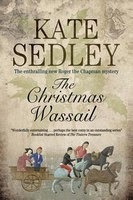 Although December 25th has come and gone, Kate Sedley’s The Christmas Wassail still made for a timely read after the holidays. It’s set in and around Bristol, England, opening on the day before Christmas Eve in the year 1483 and wrapping up after Epiphany, or Twelfth Night.
Although December 25th has come and gone, Kate Sedley’s The Christmas Wassail still made for a timely read after the holidays. It’s set in and around Bristol, England, opening on the day before Christmas Eve in the year 1483 and wrapping up after Epiphany, or Twelfth Night. All of the religious observations and traditional folk customs held over the twelve days of Christmas are included, which creates a rich cultural atmosphere. On Christmas Day, Roger the Chapman, his wife, and their blended family of four children attend three separate masses. There’s much merriment and drinking of “lamb’s wool” as people travel from house to house during their wassailing, and a group of mummers has come to town to perform.
Amid all the activity, including his investigation of a growing number of murders (since this is a mystery, after all), Roger is charged with finding a suitably large Yule log and keeping it burning for nearly a fortnight.
The crime aspect is introduced through the stabbing death of a city alderman who was a good friend of the wealthy Sir George Marvell, an ornery old man with a healthy libido and a multitude of family problems. Roger finds the victim right before he dies and hears his puzzling last word.
To the dismay of his wife, Adela, Roger has the habit of getting drawn into solving murders, both in Bristol itself and on his many peddling excursions around the countryside. It’s the second marriage for both of them, and their loving but sometimes acrimonious banter is fun to watch. Strong-willed, efficient Adela runs a tight household, or would, if Roger wasn’t away so much, meeting with friends in his favorite tavern or following wherever his curiosity leads him. Roger’s past service on behalf of the Duke of Gloucester, now Richard III, has helped his family rise in the world, so she can’t resent his work too much.
Although The Christmas Wassail is the 22nd (!) volume in the Roger the Chapman series, I didn’t feel disoriented. Enough backstory is provided so that the characters’ relationships are clear. The occasional reference to specific events from earlier volumes flew over my head, but that wasn’t a big deal. There’s enough detail on late medieval life to satisfy historical fiction readers, even those who don’t seek out mysteries. The book was published last year, and so far it marks Roger’s last appearance in fiction, which makes me wonder if there will be any others. Kate Sedley (a pseudonym) also wrote many novels set in the Middle Ages as Brenda Honeyman and Brenda Clarke, her maiden and married names.
The Christmas Wassail appeared from Severn House in 2013 ($29.95 hb, $9.99 ebook). I read it from a library copy, and wrote this review on my trip back to Illinois after spending Christmas in Orlando with my in-laws. Hope you're all having a nice holiday season!
Published on December 28, 2014 11:00
December 23, 2014
Book review: Jane Austen's First Love by Syrie James
As you can guess from the title, this gently and lovingly told novel imagines young Jane Austen’s first experience with romance, but I would have picked it up for the setting alone. An invitation to spend the summer of 1791 amid fine company at a grand manor in the English countryside was hard to resist.
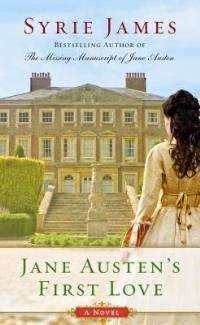 Fifteen-year-old Jane adores her siblings, including sister Cassandra and brother Edward – who had the good fortune to be adopted by wealthy relatives, and whose upcoming marriage to Elizabeth Bridges, a baronet’s daughter, will serve him well socially. In June, several family groups gather to celebrate their engagement, as well as that of Elizabeth’s sister Fanny. Goodnestone Park in Kent, the ancestral home of the Bridges family, is the center of all the festivities, which include balls, a strawberry-picking excursion, and other distracting pastimes.
Fifteen-year-old Jane adores her siblings, including sister Cassandra and brother Edward – who had the good fortune to be adopted by wealthy relatives, and whose upcoming marriage to Elizabeth Bridges, a baronet’s daughter, will serve him well socially. In June, several family groups gather to celebrate their engagement, as well as that of Elizabeth’s sister Fanny. Goodnestone Park in Kent, the ancestral home of the Bridges family, is the center of all the festivities, which include balls, a strawberry-picking excursion, and other distracting pastimes.
Jane, who hasn’t yet “come out” into society (but who has her family's permission to socialize with others within this small group), can’t help but be awed by Edward Taylor, the Bridges’ handsome neighbor. Although he’s only a year older, Mr. Taylor has a wide range of life experiences and has hobnobbed with European nobility. Most of Jane’s knowledge of the wider world comes from book-learning, but her powers of observation are sharp even as a sheltered teenager.
The scenarios that play out at Goodnestone are the author’s invention, though James has ensured that her characters’ backgrounds and personalities reflect the historical evidence. Jane’s growing affections for Edward in the novel are based on a few sentences in letters the author wrote to her sister, referring to Edward Taylor as a man with “beautiful dark eyes” upon whom she “had once fondly doated.”
Her irrepressible and impetuous wit is well evident in James’s writing, which follows Jane at a critical juncture in her young life, a time when she learns for herself not to rely on outer appearances. Beyond the sweet romance, some deeper issues are touched upon, such as the importance of individuality, the serious meaning behind silly fashion trends, and the inner struggle between ambitions that are achievable and those that aren’t.
Although I found the scenes involving the young people’s amateur theatrics to be too drawn out, I enjoyed this lighthearted excursion into a beloved author’s enigmatic past. It’s especially recommended for fans of Austen-themed fiction and country house sagas.
Jane Austen's First Love was published by Berkley in September (trade paperback, $16.00/Can$18.00, 384pp).
 Fifteen-year-old Jane adores her siblings, including sister Cassandra and brother Edward – who had the good fortune to be adopted by wealthy relatives, and whose upcoming marriage to Elizabeth Bridges, a baronet’s daughter, will serve him well socially. In June, several family groups gather to celebrate their engagement, as well as that of Elizabeth’s sister Fanny. Goodnestone Park in Kent, the ancestral home of the Bridges family, is the center of all the festivities, which include balls, a strawberry-picking excursion, and other distracting pastimes.
Fifteen-year-old Jane adores her siblings, including sister Cassandra and brother Edward – who had the good fortune to be adopted by wealthy relatives, and whose upcoming marriage to Elizabeth Bridges, a baronet’s daughter, will serve him well socially. In June, several family groups gather to celebrate their engagement, as well as that of Elizabeth’s sister Fanny. Goodnestone Park in Kent, the ancestral home of the Bridges family, is the center of all the festivities, which include balls, a strawberry-picking excursion, and other distracting pastimes. Jane, who hasn’t yet “come out” into society (but who has her family's permission to socialize with others within this small group), can’t help but be awed by Edward Taylor, the Bridges’ handsome neighbor. Although he’s only a year older, Mr. Taylor has a wide range of life experiences and has hobnobbed with European nobility. Most of Jane’s knowledge of the wider world comes from book-learning, but her powers of observation are sharp even as a sheltered teenager.
The scenarios that play out at Goodnestone are the author’s invention, though James has ensured that her characters’ backgrounds and personalities reflect the historical evidence. Jane’s growing affections for Edward in the novel are based on a few sentences in letters the author wrote to her sister, referring to Edward Taylor as a man with “beautiful dark eyes” upon whom she “had once fondly doated.”
Her irrepressible and impetuous wit is well evident in James’s writing, which follows Jane at a critical juncture in her young life, a time when she learns for herself not to rely on outer appearances. Beyond the sweet romance, some deeper issues are touched upon, such as the importance of individuality, the serious meaning behind silly fashion trends, and the inner struggle between ambitions that are achievable and those that aren’t.
Although I found the scenes involving the young people’s amateur theatrics to be too drawn out, I enjoyed this lighthearted excursion into a beloved author’s enigmatic past. It’s especially recommended for fans of Austen-themed fiction and country house sagas.
Jane Austen's First Love was published by Berkley in September (trade paperback, $16.00/Can$18.00, 384pp).
Published on December 23, 2014 07:00
December 18, 2014
What’s in a Name? Prostitution in Shakespeare’s England, a guest post by Sam Thomas
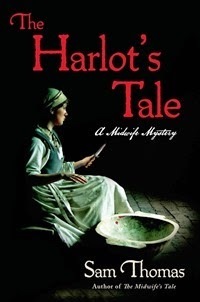 Sam Thomas is back with a yet another entertaining post marking the paperback release of
The Harlot’s Tale
, the second book in the Midwife Mystery series. This essay, the second of two, deals with prostitutes in Shakespearean times; his first post, from Tuesday, detailed how he researched their trade in early modern England.
Sam Thomas is back with a yet another entertaining post marking the paperback release of
The Harlot’s Tale
, the second book in the Midwife Mystery series. This essay, the second of two, deals with prostitutes in Shakespearean times; his first post, from Tuesday, detailed how he researched their trade in early modern England.The first book in the series, The Midwife’s Tale is currently available as an E-book for $2.99. (The link is to Amazon, but it’s available in other formats as well. Click here for more buying options.)
~
What’s in a Name? Prostitution in Shakespeare’s EnglandSam Thomas
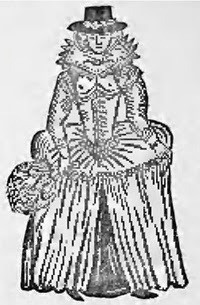 As in so many matters touching on the darker side of human behavior, the language of prostitution included all manner of synonyms and euphemisms for the simple word “prostitute.” There was meretrix (from the Latin), putain (French), strumpet, whore, stew (from the infamous brothels, known as “stews of Rome”), quean (or, in many cases, abominable quean!), and harlot.
As in so many matters touching on the darker side of human behavior, the language of prostitution included all manner of synonyms and euphemisms for the simple word “prostitute.” There was meretrix (from the Latin), putain (French), strumpet, whore, stew (from the infamous brothels, known as “stews of Rome”), quean (or, in many cases, abominable quean!), and harlot. When I started writing The Harlot’s Tale, I had no idea what I would call it. It was pretty clear that it would be Somebody’s Tale, but whose? I ran through a number of possibilities, most of which had the down-side of hinting at (or announcing!) the identity of the killer. I didn’t want to do this, because Rule #1 of Mystery Writing is: “Do not give away the identity of the killer in the title of your book.”
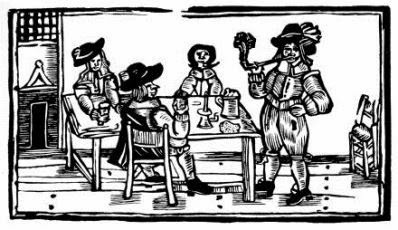
I ultimately settled on The Harlot’s Tale, both because I liked the Biblical feel of the word, and because the book is set in the aftermath of the Puritan capture of the city of York, when the godly were riding high. But as I did more research on prostitution in medieval and early modern England, names for individual prostitutes came to light, and it turns out that these individuals could be quite creative in establishing pseudonyms.
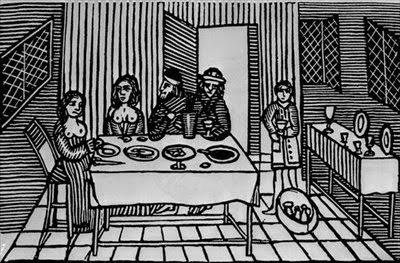
The first I discovered was "Spanish Jane," who – you will not be surprised to learn – was in no way Spanish. More alarming was "Claire Clatterbollocks." (If you are unfamiliar with the term ‘bollocks’ they are a rather coarse term for a man’s delicate bits.) Finally, there was a sex-worker whose given name was John Rykener, but worked under the name "Eleanor." The historical record is regrettably silent on the question of what John/Eleanor’s clients thought they were getting for their money!
~
Sam Thomas is the author of The Midwife Mysteries. To win a copy of The Harlot’s Tale, leave a comment on this page, head over to his Facebook page, or send him an email. For more information on the history and mystery of midwifery, visit Sam’s website.
Published on December 18, 2014 05:00



